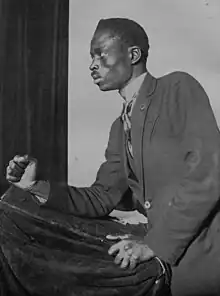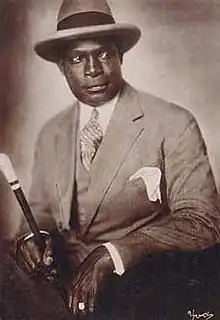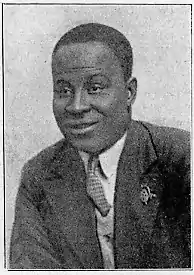Ligue de défense de la race nègre
The Ligue de défense de la race nègre (League for the Defense of the Negro Race) was an originally French civil rights organization of Black people. It was founded in 1927 out of a predecessor organization whose roots went back to 1924. Its headquarters were in Paris, but in 1932 the French organization was disbanded. Under the name Liga zur Verteidigung der Negerrasse, there was a German section in Berlin from 1929 to 1935.

History of origins
Ligue universelle de défense de la race noire
The Ligue universelle de défense de la race noire was founded on April 30, 1924, by Kojo Tovalou Houénou, descendant of the last king of Dahomey, who also acted as chairman. It was the first major rallying organization of specifically Caribbean- as well as African-descended black people in France. It published the bimonthly journal Les Continents from May 1924, headed by René Maran.[1] Tovalou negotiated (unsuccessfully) with activists such as W. E. B. Dubois and Marcus Garvey during a trip to the United States in August 1924 to make Paris the headquarters of an international Pan-African organization. Upon his return to Paris, these contacts were deemed dangerous by French authorities and Tovalou was forced to leave the country. The simultaneous publication in the magazine of a sharp text by Maran against the first African member of the French parliament, Blaise Diagne, led to a libel suit. Weakened by the absence of its chairman, the Ligue disbanded.[2][3]
Comité de défense de la race nègre
From the ranks of the dissolved Ligue, Lamine Senghor and Joseph Gothon-Lunion founded a successor organization, the Comité de Défense de la Race Nègre (CDRN), in March 1926.[2] It edited the magazine La Voix des Negres.[4] Particularly through the efforts of Senghor, who traveled through French port cities and gave speeches to workers, offshoots of the Comité de Défense were founded there as in West Africa.[5] In 1926, the Comité had about 1000 members, 250 in Marseille, 150 in Bordeaux, 300 in Le Havre and 200 in Paris.[2]
However, content-related disputes quickly developed in the leadership of the Comité. On the one hand, there was the question of whether the term nègre or the term noir should serve as a self-designator - the retention of the term nègre was important to Senghor; he wanted to reappropriate the term and "pull this word out of the mud through which they drag it to make it a symbol." According to him, the term nègre symbolized African origins and political radicalism, whereas noir was associated with colonialist political ideas.[2]
At the center, however, was the question of the group's political radicalism. The assimilationist part of the committee was concerned with the decidedly anti-colonial as well as more working-class and consequently communist orientation of the Left Fraction and its willingness to openly criticize the French government, which could be interpreted as anti-French. These disputes led to a split in the CDRN at a general meeting on February 27, 1927. The moderate faction under Afro-Caribbean leadership took over the Comité and renamed it the Comité de défense de la race noire.[2]
Ligue de Défense de la Race Nègre
As a result of the split, Senghor, Tiemoko Garan Kouyaté, and Camille Sainte-Rose founded the Ligue de Défense de la Race Nègre in May 1927, initially led by Senghor.[2] From June, the monthly magazine La Race Nègre appeared as the publication of the group.[6]
Now without restrictions from the moderate and assimilationist members, the League formulated anti-colonialist positions such as the demand for independence of the colonies and linked them with communist ideas. It had active groups in all major port cities, with a total of about 1,000 members. Like its predecessor and successor organizations, the LDRN was monitored by the authorities. Of the 50 or so members spied on in Paris, about half worked as service providers or laborers, 7 were students and 5 were lawyers, and the rest were mostly small employees.[2]
While there was agreement on the basic anti-colonial principle, the exact demands within the group were quite variable. While some members articulated nationalist positions, others espoused pan-Africanist ideas. Although independence of any kind for the colonies was an undisputed common goal, the group also fought for improvements in the everyday status quo of French Africans. The communist ideas cultivated by the leadership repeatedly met with misgivings in parts of the group because this would keep out anti-imperialist-minded but noncommunist possible members of the group. Ludovic Lacombe, a Haitian member of the group, put it this way, saying that he was a "nationalist but anti-Communist Negro who did not want a master, white or red."[2]
Senghor died as late as 1927. He was succeeded by Tiemoko Garan Kouyaté, who in the following years built up an international network, including with a Congolese group in Brussels, a short-lived group around Jomo Kenyatta in London, with American activists such as W. E. B. Du Bois, and in French colonies such as Senegal and Cameroon. To Cameroon, Kouyaté also smuggled in propaganda material, which greatly alarmed French authorities. For a short time, there was also a direct offshoot of the league in Kribi.[7] In 1931, a dispute over the leadership of the group began between the communist wing around Kouyaté and a "merely" anti-imperialist wing around Émile Faure.[2] Then, in April 1931, two different issues of La Race Nègre appeared, one by Émile Faure, André Béton, and Ludovic Lacombe, the other by Kouyaté. In August, Kouyaté changed the title of his journal to Le Cri des Nègres and in 1932 founded the Union des travailleurs nègres as an undogmatic communist successor to the Ligue, but it was soon taken over by dogmatic communists and expelled Kouyaté. In 1939, the UTN dissolved itself.[2]
The German chapter - Liga zur Verteidigung der Negerrasse
In Berlin on September 17, 1929, seven men from Douala, Cameroon founded the Liga zur Verteidigung der Negerrasse (LzVN). With this step, they opposed worsening economic difficulties and racial prejudice in Germany and wanted to establish a network for mutual moral and financial support.[7]Over the course of the year, about 30 black men and women came together, some of whom had already met in the Afrikanischer Hilfsverein, which had disbanded in the mid-1920s.[8] The founding of the German section of the LDRN was supported by Willi Münzenberg, founder of the League Against Imperialism, who had already been bringing together important people from the African community in Berlin for anti-colonialist motives since 1926. He also established contact with Tiemoko Garan Kouyaté, who was present at the founding meeting.[9] A few months earlier, Kouyaté had already had copies of La Race Nègre distributed in Berlin via Münzenberg.[7]

Most members came from the former German colony of Cameroon, some from West Africa, such as Togo. All black Germans and their relatives could become members of the association. The president was Victor Bell, other board members were Thomasul Kuo Ngambi, Louis Brody, Richard Ekamby Menzel and, as secretary general and central figure, the Pan-Africanist and communist Joseph Bilé, who was increasingly active in international politics with the help of his mentors George Padmore and Kouyaté.[8][7]

In its statutes, it declared as the purpose of the association to achieve the "liberation of the Negroes" internationally and to fight nationally for a large, independent African state.[7] It advocated the independence of African states, especially the defense of the independence of Liberia and Ethiopia, encouraged black Germans to join German unions, and urged its members to provide mutual moral and material support, a legacy from the Afrikanischer Hilfsverein.[9]
The LzVN was organizationally part of the League Against Imperialism, was financed by it and also had its headquarters in its rooms at Friedrichstraße 24.[9] It cooperated with the Communist International and a larger network of black internationalist organizations and activists in Europe and Africa, in addition to its French sister organization.[10] The group smuggled political writings such as the statutes of the LzVN, among others, to Cameroon and maintained contact with activists there; most likely, they were also involved in anti-colonial protests in Duala.[7] In 1930, the group performed Brody's play Sunrise in the Orient in Neukölln, the first half in Duala, the second in French, English and German. The play presented African history and culture of Africans probably for the first time in Germany without resorting to contemporary stereotypes.[9] However, plans to establish its own "race theater" were not realized because the financial resources expected by the Ligueof Kouyaté were not available.[7] Also in 1930, Bilé attended the First International Conference of Negro Workers in Hamburg as a delegate of the LzVN, which enhanced his status within the anti-colonial movement, as did subsequent discussions about him in the League Against Imperialism and the Comintern, which earmarked him for training in Moscow and deployment as an agitator in Africa.[7]
As the debate over Bilé continued, there were also accusations by the LzVN against the League Against Imperialism that it was not providing the group with sufficient financial support. According to Bilé, the responsible supervisors, Virendranath Chattopadhyaya and Bohumír Šmeral, had failed to honor several funding pledges; according to Kouyaté, Chattopadhyaya had even opposed any further funding for the group, seeing it as no loss if it disbanded. As a result, the LzVN refused to continue working with the LgI and instead turned to the KPD for support. Although this pacified the conflict, the personal hardship of the members led to internal squabbles and intrigue. With the Nazi seizure of power, the group became defenseless. The KPD and the League Against Imperialism had been dissolved, Padmore and Münzenberg had left the country, and Kouyaté had been expelled from the French Ligue. As a result, the LzVN ceased its work completely. Many members of the LzVN left Germany; by August 1934, according to Bell, the group had only two members left.[7] In 1935 the group was officially disbanded.[9]
References
- T. Denean Sharpley‐Whiting (September 2000), "Femme négritude : Jane Nardal, La Dépêche africaine, and the francophone new negro", Souls, vol. 2, no. 4, pp. 8–17, doi:10.1080/10999940009362232, ISSN 1099-9949
- Jennifer Anne Boittin (2009), "Black in France: The Language and Politics of Race in the Late Third Republic", French Politics, Culture & Society, vol. 27, no. 2, pp. 23–46, ISSN 1537-6370, JSTOR 42843598
- Maelenn-Kegni Toure (2009-02-26). "Ligue Universelle pour la Défense de la Race Noire (1924)". BlackPast.org. Retrieved 2023-09-28.
- "La Voix des Nègres". SISMO (Portail Mondial des Revues) (in French). Institut national d'histoire de l'art (INHA). Retrieved 2023-09-28.
- Brigitte Matern (2022-03-16). "Rebell:innenrätsel: Der lästige Kriegsversehrte". Die Wochenzeitung (in German). Retrieved 2023-09-28.
- "La Race Nègre". SISMO (Portail Mondial des Revues). Institut national d'histoire de l'art (INHA). Retrieved 2023-09-28.
- Robbie Aitken (October 2008), "From Cameroon to Germany and Back via Moscow and Paris: The Political Career of Joseph Bilé (1892–1959), Performer, "Negerarbeiter" and Comintern Activist", Journal of Contemporary History, vol. 43, no. 4, pp. 597–616, doi:10.1177/0022009408095417, ISSN 0022-0094
- Robbie Aitken (2022), Bundeszentrale für politische Bildung (ed.), "Black Germany - Zur Entstehung einer Schwarzen Community in Deutschland" (PDF), Aus Politik und Zeitgeschichte, vol. 72, no. 12, pp. 4–10, retrieved 2022-03-23
- Robbie Aitken (2019-06-13). "Berlin's Black Communist". Rosa-Luxemburg-Stiftung. Retrieved 2023-09-28.
- Stefan Gerbing (2010), Afrodeutscher Aktivismus: Interventionen von Kolonisierten am Wendepunkt der Dekolonisierung Deutschlands 1919, Frankfurt am Main: Peter Lang Internationaler Verlag der Wissenschaften, pp. 15ff., ISBN 3631613946